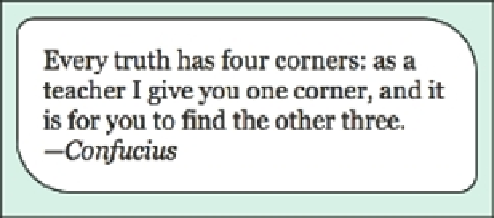Graphics Programs Reference
In-Depth Information
Figure 5-26: Corners of unequal radius.
h ere are also properties that let you set each corner individually. h e unprei xed versions are
border-top-right-radius
,
border-bottom-right-radius
,
border-bottom-
left-radius
, and
border-top-left-radius
. Each one takes either one or two values:
One value gets you a circular arc, and two values gets you an elliptical. h e slash is only used
on
border-radius
, and is necessary there to distinguish one result (circular corners of
dif ering sizes) from another (same-size corners that are elliptical).
In fact, the individual-corner properties come in handy if you want to support WebKit. h at's
because while it doesn't support value patterns like
20px 60px
, it does support individual
corner properties. So in order to get Figure 5-26 in both Gecko- and WebKit-based browsers,
you'd write:
179
.rounded
{
background
:
#FFF
;
border
:
2px
solid
#000
;
-webkit-border-radius
:
20px
;
-webkit-border-top-right-radius
:
60px
;
-webkit-border-bottom-left-radius
:
60px
;
-moz-border-radius
:
20px
60px
;
border-radius
:
20px
60px
;}
Ugly, but ef ective.
CSS SPRITES
A technique i rst popularized by Dave Shea (of CSS Zen Garden fame) way back in 2004, CSS
sprites are a way of having really fast hover ef ects. h ey've since become a way of reducing
server load by bundling decorative images together into a single download.
h e basic example of a CSS sprite is one that contains two states for an icon—say, one for
normal display next to a link, and a “lit up” version for when the link is hovered. h e image
looks like Figure 5-27.

























Search WWH ::

Custom Search